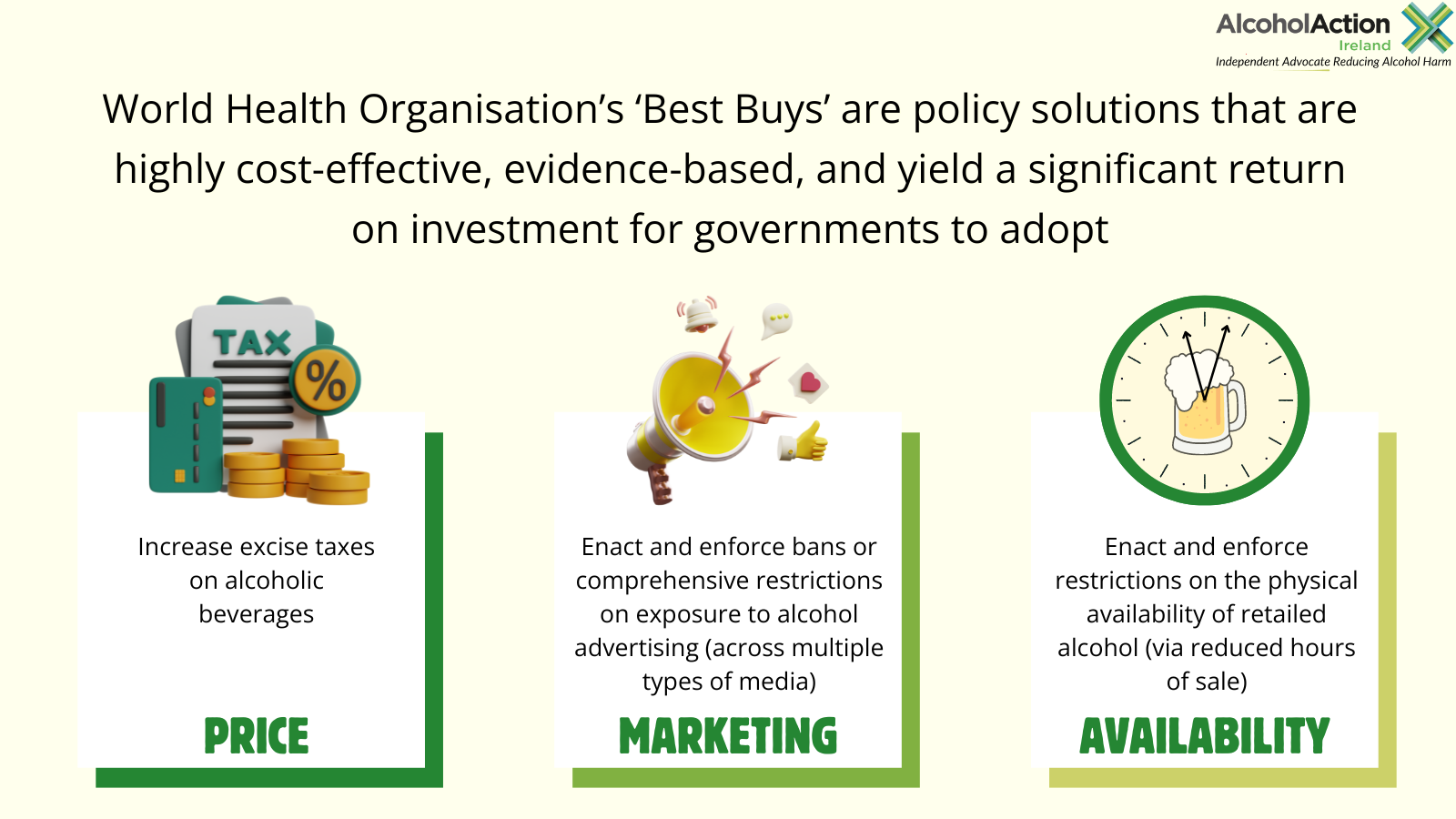Alcohol: harm reduction policy's ‘best buys’

Alcohol use causes approximately 3 million deaths globally every year and the overall burden of disease and injuries attributable to alcohol remains unacceptably high.
According to the World Health Organisation (WHO), ‘the global epidemic of Non-Communicable Diseases (NCDs)’ can be averted through interventions and policies that reduce major risk factors.
The WHO identifies the following priority actions for alcohol policy in its so called- Best Buys –
- Pricing to help regulate demand for alcoholic beverages
- Restrictions or bans on alcohol advertising
- Restrictions on the availability of alcoholic beverages
Essentially, the WHO contends that interventions on price, promotion and availability are the most effective public policy measures that governments can take to offset at least some of the harm caused by alcohol.
In Ireland, the Public Health Alcohol Act has at least begun this country’s journey in implementing some of the WHO’s best buys. See below for an overview of how Ireland is faring under each of the main measures.
Price
There is strong evidence that pricing is the single most effective control measure in respect of alcohol. The recently published Lancet Commission report outlines the evidence, as does the aforementioned recent OCED report, which highlights the affordability of alcohol in Ireland has more than doubled in the last two decades.
This is driven by two principal factors: hyper price discounting within the retail sector and the failure of successive governments to align alcohol excise duties with that of inflation. Therefore, in order to fulfill the WHO’s best buys, all alcohol excise rates should be aligned to a consumer price index.
In respect of the retail sector, Minimum Unit Pricing was introduced in Ireland in January 2022 and this is very welcome. However, we need to learn from mounting evidence from Scotland that MUP needs to be linked to a cost-of-living index. Otherwise we face the situation that this proven financial mechanism to reduce alcohol-related harms will be rendered ineffective over time.
Read more about pricing policy here.
Promotion
The Public Health (Alcohol) Act 2018 (PHAA) has started Ireland’s journey towards curbing pervasive alcohol marketing by banning alcohol advertising in certain locations where children are likely to be present. However, alcohol brands are engaging in surrogate and/or alibi marketing which means switching out the alcohol product for either a 0% alcohol product or a word or image synonymous with the brand.
Other important measures to curb marketing have yet to be commenced, including Section 12 – Health information labelling of alcohol products, Section 13 – Content of Advertisements, 18 – Advertisements in Publications, and Section 19 Broadcast watershed.
All of these measures are important because the prevalence and nature of alcohol marketing helps to normalise – and glamourise – alcohol, creating a culture where alcohol is seen as an ‘essential part’ of everyday life. Sports sponsorship is particularly egregious and the alcohol industry accounts for 20% of all sports sponsorship agreements worldwide.
In recent years, some sporting organisations such as the GAA have started to move away voluntarily from an association with alcohol brands. Sections 15 and 16 of the PHAA which came into operation in November 2021, also provide for some modest restrictions on alcohol marketing in sport. However, much more remains to be done and statutory means are required to bring about a sea change in Ireland on this issue.
Availability
Availability of alcohol concerns both the density of alcohol outlets in the on and off-trade as well as the length of trading hours. Increasingly there are also concerns about online alcohol trading. For the first time, alcohol availability in Ireland was examined in 2024 by the Health Research Board, revealing that almost ¾ of the population live within walking distance (300 meters) of a licenced premises and that there is a greater density of these premises in more deprived communities.
Outlet density
In respect of tackling alcohol use in communities, it is vital that government policy understands the alcohol-harm paradox – that is the evidence that individuals in higher socioeconomic status groups are more likely to report exceeding recommended drinking limits, but those in lower socioeconomic status groups experience more alcohol-related harm.
Research has shown that that neighbourhoods with a higher density of alcohol outlets have higher levels of both alcohol consumption and alcohol related harm. In order to protect communities from alcogenic environments, it is incumbent on government to monitor supply and availability of alcohol products and ensure that those in the lowest income groups are not disproportionately affected by outlet density.
The recently commenced Section 4 of the PHAA means that notice of grant or renewal of a license to sell alcohol must be given to the Health Service Executive. For the first time there will be a public health perspective on such licences.
Opening Hours
There is considerable evidence which points to the level of increased harm from increased opening hours. For example, a study from Norway in 2012 found that each additional 1-hour extension to the opening times of premises selling alcohol was associated with a 16% increase in violent crime.
There are proposals for a new Sale of Alcohol Bill to reform current licensing regulations in Ireland. While there is a need to streamline some aspects of these regulations it is vital that a public health perspective is taken when considering any changes which could lead to greater availability of alcohol. This would be contrary to the WHO’s best buys and indeed many of the aspirations of the PHAA.
Read more here
